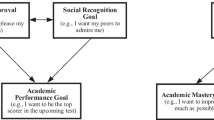Abstract
This chapter describes one way in which future research might increase our understanding of how goal-structuring interventions are related to basic classroom achievement and classroom social interaction processes in heterogeneous classrooms. It proposes a merging of nonexperimental data-analysis techniques with experimental or quasi-experimental treatments. By merging the two approaches and collecting the data necessary for each, researchers should be able to examine the ways in which cooperative learning interventions impact basic educational processes. For example, goal-structuring interventions could possibly affect outcomes by mediating the effects of variables that are part of achievement processes, enhancing the impact of variables already present in the classroom, or injecting new sources of influence into the classroom. Of these alternatives, the middle one might be viewed as the most interesting, for it is intriguing to think of cooperative learning as a catalyst that triggers a reaction from variables that are commonly present in contact situations. Least interesting is the notion of cooperative learning interventions’ acting as mediating variables, for if such interventions merely mediate effects already present, their impact on classroom processes could not be very great.
Access this chapter
Tax calculation will be finalised at checkout
Purchases are for personal use only
Preview
Unable to display preview. Download preview PDF.
Similar content being viewed by others
References
Allport, G. W. The nature of prejudice. New York: Addison-Wesley, 1954.
Aronson, E. The social animal (2nd ed.). San Francisco: W. H. Freeman, 1976.
Asch, S. E. Social psychology. Englewood Cliffs, N.J.: Prentice-Hall, 1952.
Bachman, J. G., & O’Malley, P. M. Self-esteem in young men: A longitudinal analysis of the impact of educational and occupational attainment. Journal of Personality and Social Psychology, 1977, 35, 365–380.
Cohen, E. G. Design and redesign of the desegregated school: Problems of status, power, and conflict. In W. G. Stephan & J. R. Feagin (Eds.), Desegregation: Past, present, and future. New York: Plenum Press, 1980.
Coleman, J. S., Campbell, E. Q., Hobson, C. J., McPartland, J., Mood, A. M., Weinfeld, F. D., & York, R. L. Equality of educational opportunity. Washington: U.S. Government Printing Office, 1966.
Cook, S. W. Motives in a conceptual analysis of attitude-related behavior. In W. J. Arnold & D. Levine (Eds.), Nebraska Symposium on Motivation, 1969. Lincoln: University of Nebraska Press, 1970.
Crain, R. L., & Weisman, C. S. Discrimination, personality, and achievement: A survey of Northern Blacks. New York: Seminar Press, 1972.
Deutsch, M., & Gerard, H. B. A study of normative and informational social influence upon individual judgment. Journal of Abnormal and Social Psychology, 1955, 51, 629–636.
Fishbein, M., & Ajzen, I. Belief, attitude, intention, and behavior: An introduction to theory and research. Reading, Mass.: Addison-Wesley, 1975.
Frank, M. J. A comparison between an individual and group goal structure contingency that differed in the behavioral contingency and performance-outcome components. Unpublished doctoral dissertation, University of Minnesota, Minneapolis, 1984.
Gerard, H., & Miller, N. School desegregation. New York: Plenum Press, 1975.
Johnson, D. W., Maruyama, G., Johnson, R. T., Nelson, D., & Skon, L. Effects of cooperative, competitive, and individualistic goal structures on achievement: A metaanalysis. Psychological Bulletin, 1981, 89, 47–62.
Johnson, D. W., Johnson, R. T., & Maruyama, G. Interdependence and interpersonal attraction among heterogeneous and homogeneous individuals: A theoretical formulation and a meta-analysis of the research. Review of Educational Research, 1983, 53, 5–54.
Jones, E. E., & Gerard, H. B. Foundations of social psychology. New York: Wiley, 1967.
Jöreskog, K. G., & Sörböm, D. LISREL IV: Estimation of linear structural equation systems by maximum likelihood methods. Chicago: National Educational Resources, 1978.
Lewis, R., & St. John, N. Contribution of cross-racial friendship to minority group achievement in desegregated classrooms. Sociometry, 1974, 37, 79–91.
Maruyama, G. A causal-model analysis of variables related to primary school achievement. Doctoral dissertation, University of Southern California. (Dissertation Abstracts International, 1977, 38, 1470B.)
Maruyama, G. What causes achievement? An examination of antecedents of achievement in segregated and desegregated classrooms. In D. E. Bartz & M. L. Maehr (Eds.), The effects of school desegregation on motivation and achievement. Greenwich, Conn.: JAI Press, 1983.
Maruyama, G., & McGarvey, B. Evaluating causal models: An application of maximum likelihood analysis of structural equations. Psychological Bulletin, 1980, 87, 502–512.
Maruyama, G., & Miller, N. Re-examination of normative influence processes in desegregated classrooms. American Educational Research Journal, 1979, 16, 273–283.
Maruyama, G., & Miller, N. Does popularity cause achievement? A longitudinal test of the lateral transmission of values hypothesis. Paper presented at the Annual Meeting of the American Educational Research Association, Boston, April 1980.
Maruyama, G., Rubin, R. A., & Kingsbury, G. G. Self-esteem and educational achievement: Independent constructs with a common cause? Journal of Personality and Social Psychology, 1981, 40, 962–975.
McGarvey, W. E. Longitudinal factors in school desegregation. Doctoral dissertation, University of Southern California. (Dissertation Abstracts International, 1978, 38, 5097B.)
Newcomb, T. M. Personality and social change. New York: Dryden, 1943.
Sharan, S. Cooperative learning in small groups: Recent methods and effects on achievement, attitudes, and ethnic relations. Review of Educational Research, 1980, 50, 241–271.
Slavin, R. E. Cooperative learning. Review of Educational Research, 1980, 50, 315–342.
U.S. Commission on Civil Rights. Racial isolation in the public schools: A report. Washington D.C.: Government Printing Office, 1967.
Watson, G. Action for unity. New York: Harper, 1947.
Webb, N. M. Student interaction and learning in small groups. Review of Educational Research, 1982, 52, 421–455.
Author information
Authors and Affiliations
Editor information
Editors and Affiliations
Rights and permissions
Copyright information
© 1985 Springer Science+Business Media New York
About this chapter
Cite this chapter
Maruyama, G. (1985). Relating Goal Structures to Other Classroom Processes. In: Slavin, R., Sharan, S., Kagan, S., Hertz-Lazarowitz, R., Webb, C., Schmuck, R. (eds) Learning to Cooperate, Cooperating to Learn. Springer, Boston, MA. https://doi.org/10.1007/978-1-4899-3650-9_13
Download citation
DOI: https://doi.org/10.1007/978-1-4899-3650-9_13
Publisher Name: Springer, Boston, MA
Print ISBN: 978-1-4899-3652-3
Online ISBN: 978-1-4899-3650-9
eBook Packages: Springer Book Archive




